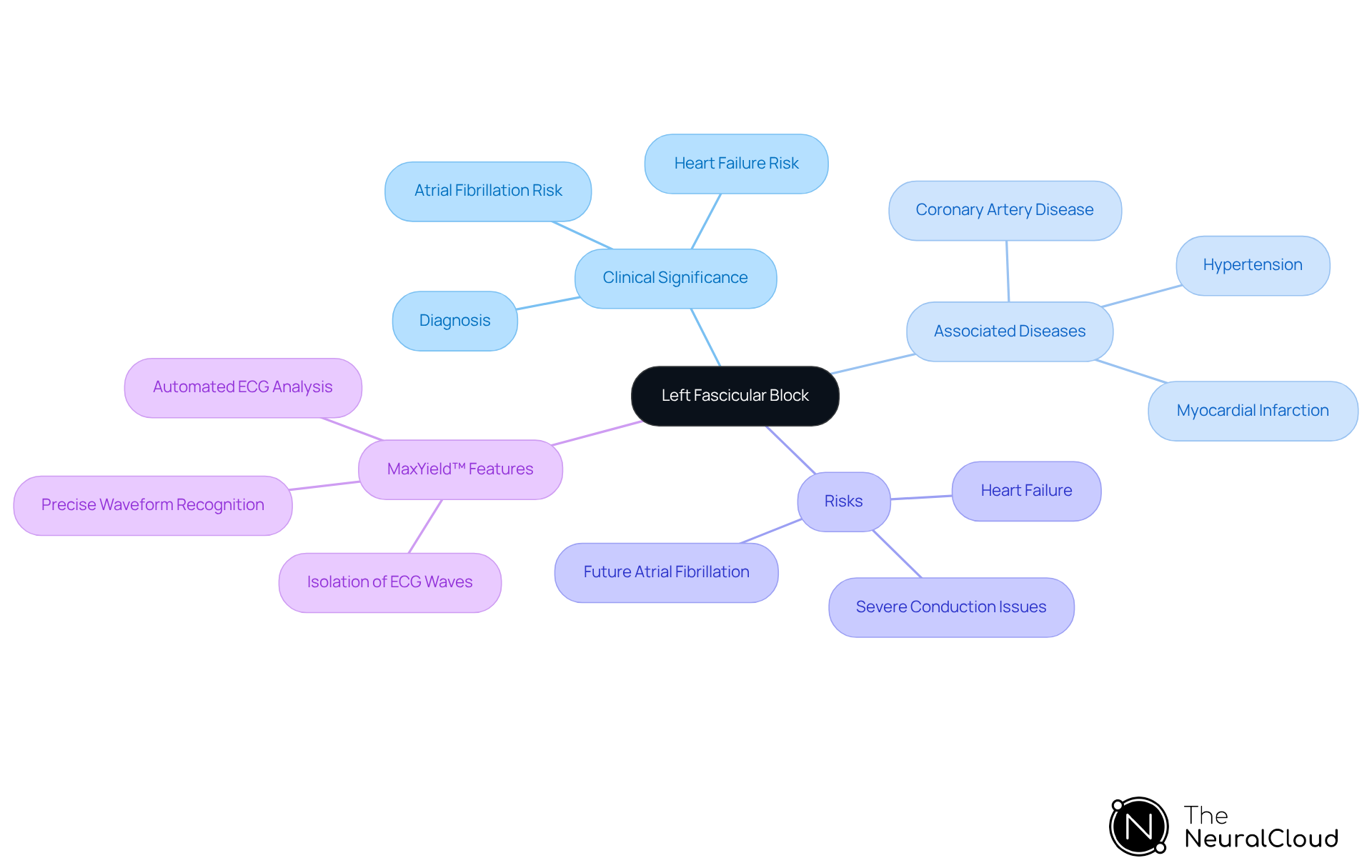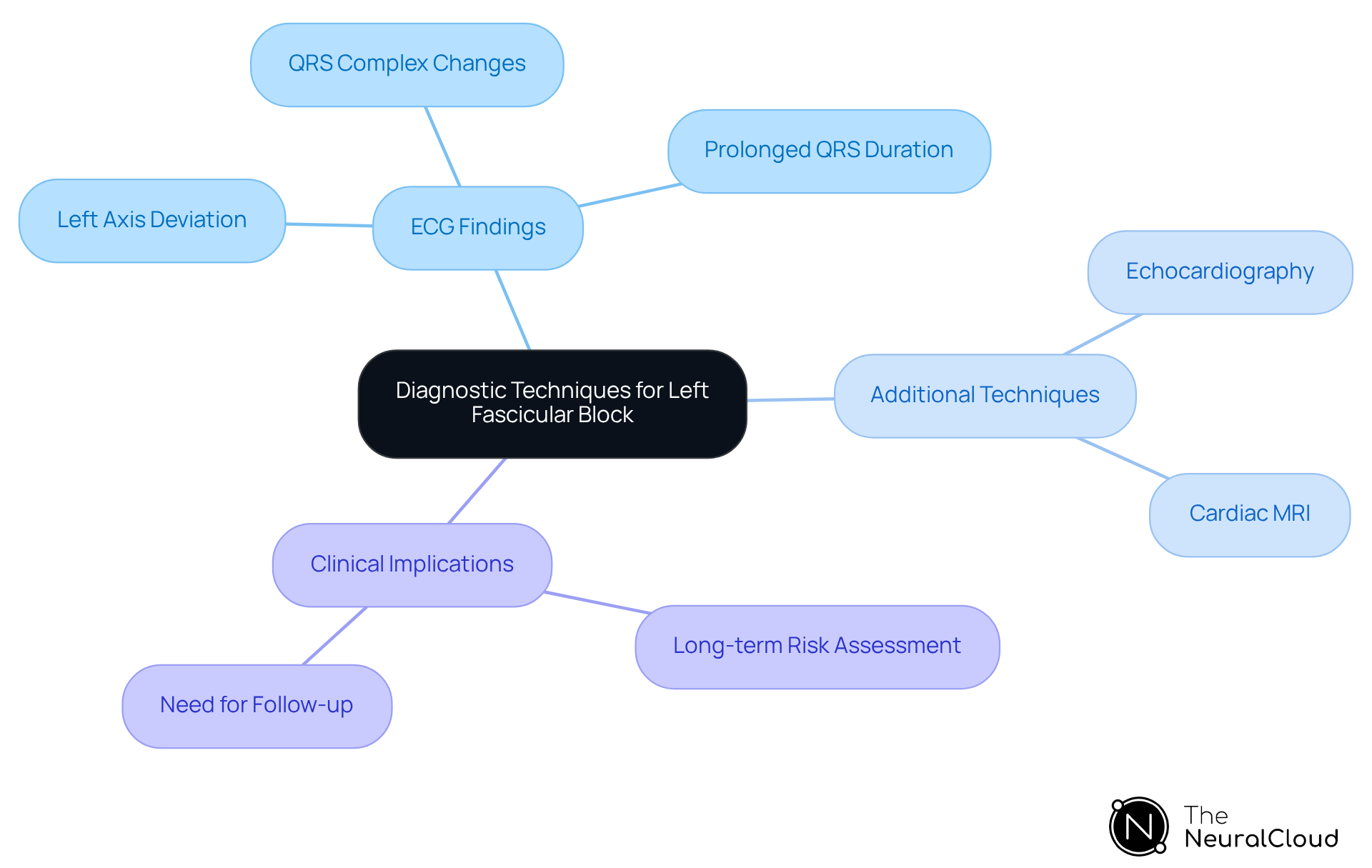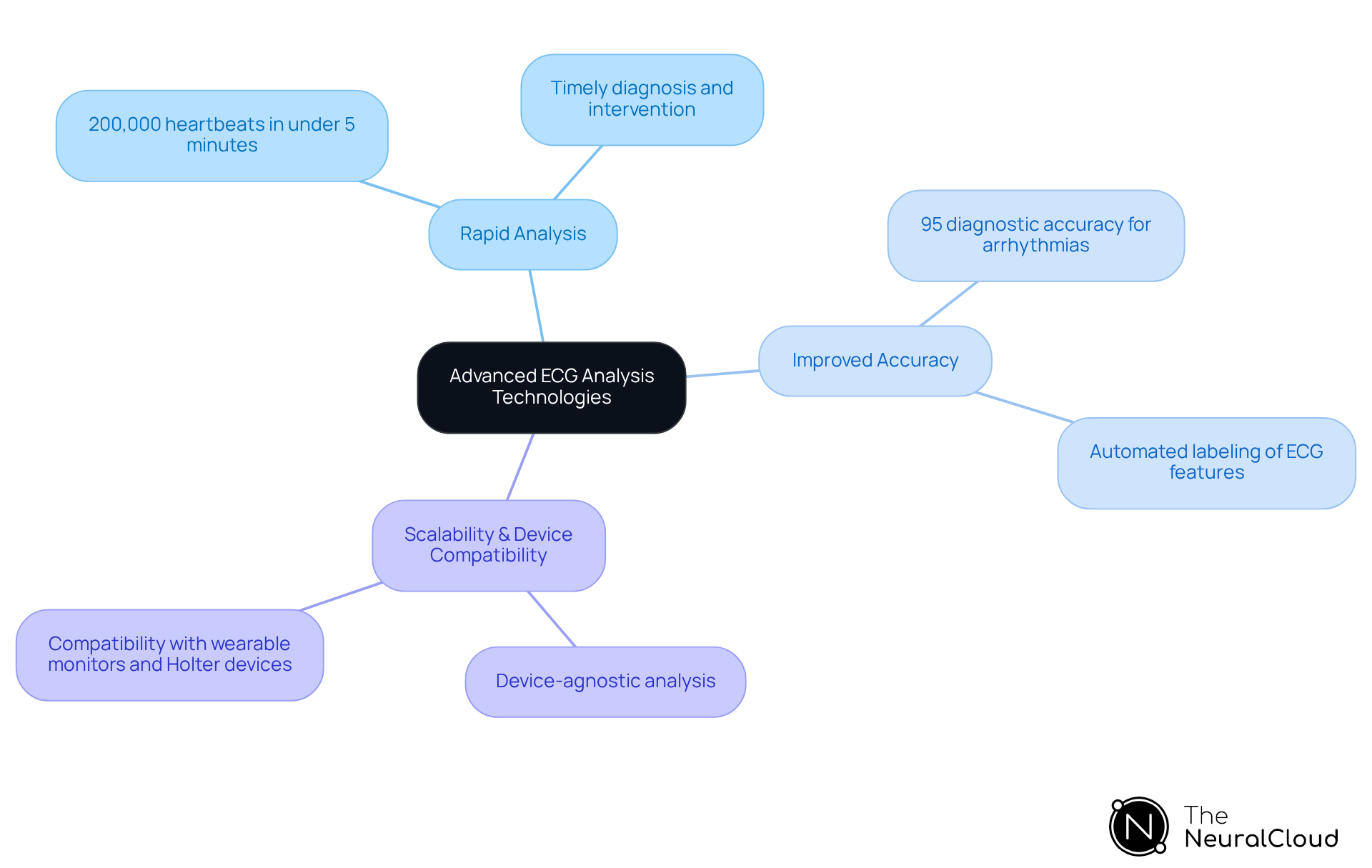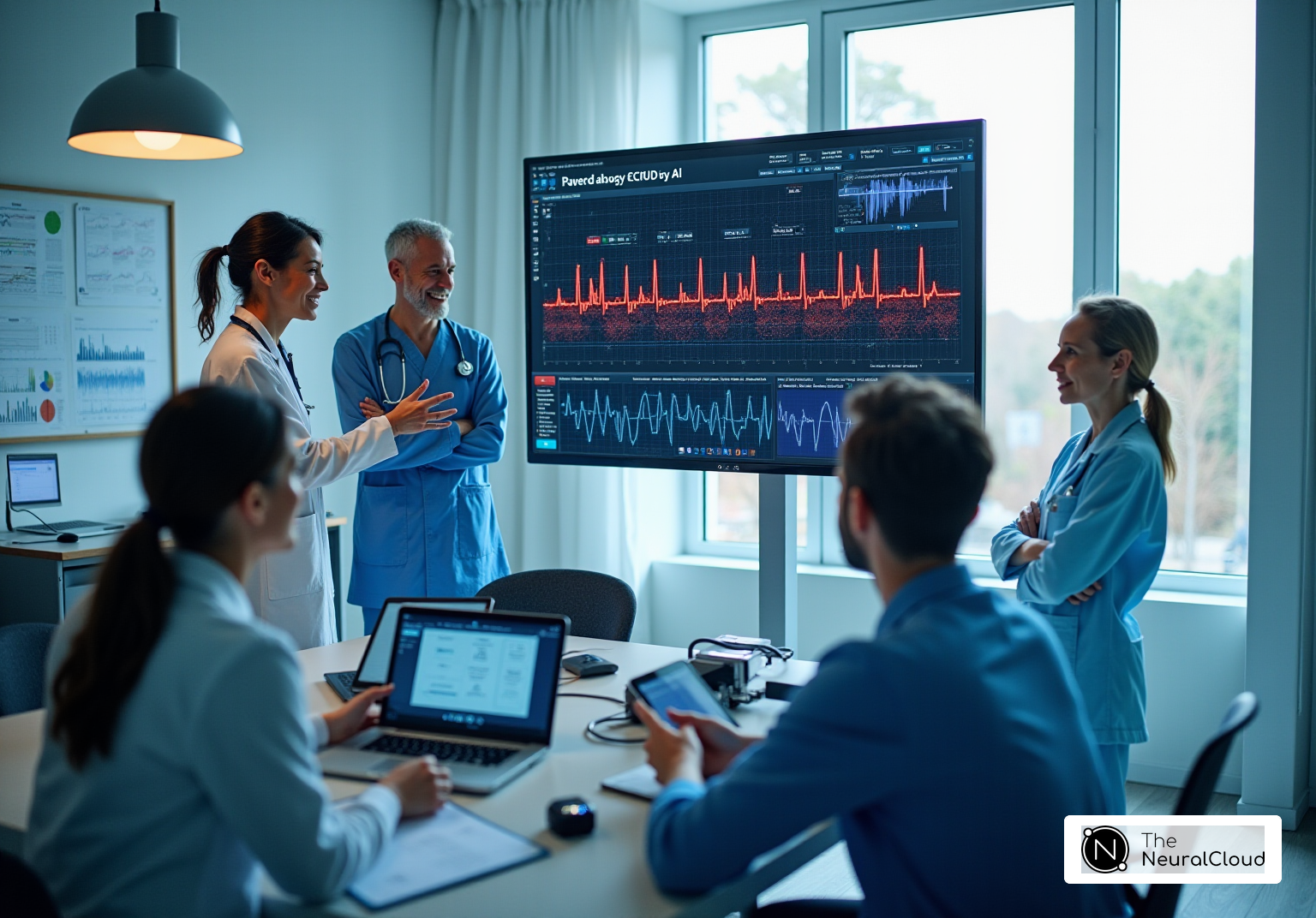Overview
The article provides an overview of Left Fascicular Block (LAFB), a conduction abnormality linked to various heart diseases, highlighting the challenges associated with ECG analysis. It underscores the critical need for timely diagnosis, emphasizing the role of advanced technologies such as Neural Cloud Solutions' MaxYield™ platform in improving diagnostic accuracy. The features of MaxYield™ are designed to enhance ECG analysis, offering healthcare professionals a reliable tool for identifying LAFB and other conduction abnormalities.
The MaxYield™ platform boasts several key features that streamline the diagnostic process:
- By utilizing sophisticated algorithms and data analytics, it increases the precision of ECG readings, enabling healthcare providers to make informed decisions swiftly.
- This technological advancement not only reduces the likelihood of misdiagnosis but also enhances the overall efficiency of patient management in clinical settings.
In addressing the underlying conditions associated with LAFB, the article emphasizes the importance of comprehensive management strategies. Effective treatment hinges on understanding the patient's unique clinical profile and the specific heart disease present. By leveraging the capabilities of MaxYield™, healthcare professionals can better tailor their approaches, ultimately leading to improved patient outcomes and enhanced quality of care.
In conclusion, the integration of advanced diagnostic tools like MaxYield™ is essential for addressing the complexities of ECG analysis and the management of conditions such as LAFB. This platform not only aids in accurate diagnosis but also supports healthcare providers in delivering optimal patient care through informed decision-making.
Introduction
Left fascicular block represents a significant conduction abnormality that can act as a silent precursor to severe cardiovascular issues, frequently remaining undetected until it appears on an electrocardiogram (ECG). Grasping its clinical importance is essential for healthcare professionals, as an early diagnosis can significantly influence treatment paths and enhance patient outcomes.
The primary challenge, however, lies in differentiating between benign variations and those that indicate more serious underlying conditions. This raises an important question: how can advanced diagnostic techniques and innovative technologies improve the accuracy of identifying left fascicular block and understanding its implications?
Define Left Fascicular Block and Its Clinical Significance
Left fascicular block is a conduction abnormality characterized by a delay or obstruction in electrical impulses through the left anterior fascicle of the left bundle branch. This condition typically results in left axis deviation on an electrocardiogram (ECG), serving as a crucial diagnostic indicator. Clinically, left fascicular block holds significant implications as it is often associated with underlying heart diseases, including coronary artery disease, hypertension, and myocardial infarction.
Recent studies indicate that individuals with new fascicular blocks are at a heightened risk for future atrial fibrillation and heart failure, emphasizing the significance of timely diagnosis and management. Furthermore, this condition can be a precursor to more severe conduction issues, necessitating careful evaluation and potential intervention. For example, case studies show that individuals demonstrating left anterior fascicular block may display discordant ST changes, which necessitate comprehensive evaluation to distinguish between harmless and alarming findings.
This comprehension is essential for healthcare professionals, as identifying left fascicular block can impact treatment approaches and enhance patient results. The incorporation of Neural Cloud Solutions' platform can greatly improve the examination of left anterior fascicular block by offering automated ECG analysis that reduces noise and precisely recognizes essential waveforms. The system quickly isolates ECG waves from recordings impacted by artifacts, ensuring that clinicians can recover previously hidden segments of lengthy Holter and patch monitor recordings.
Features of MaxYield™:
- Automated ECG analysis to reduce noise.
- Precise recognition of essential waveforms.
- Isolation of ECG waves from artifact-affected recordings.
Advantages for Healthcare Professionals:
- Enhanced ability to assess low amplitude fluctuations in the brain.
- Effective differentiation between benign and concerning findings.
- Improved diagnostic accuracy and treatment strategies.
By leveraging MaxYield™, clinicians can enhance their diagnostic accuracy and treatment strategies, ultimately leading to better patient outcomes.

Outline Diagnostic Techniques for Left Fascicular Block
The electrocardiogram (ECG) serves as the primary diagnostic tool for identifying left fascicular block. Key ECG findings indicative of LAFB include:
- Left Axis Deviation: Typically observed between -45° and -90°, this deviation is a hallmark of LAFB.
- QRS Complex Changes: Characteristic patterns include qR complexes in leads I and aVL, alongside rS complexes in leads II, III, and aVF, which are essential for accurate diagnosis.
- Prolonged QRS Duration: While the QRS duration is generally less than 0.12 seconds, any significant prolongation should be carefully evaluated as it may indicate additional conduction issues.
The 'Neural Cloud Solutions' platform enhances the efficiency of ECG analysis by leveraging advanced noise filtering and distinct wave recognition capabilities. This technology facilitates the rapid isolation of ECG waves from recordings that may be compromised by baseline wander, movement, and muscle artifacts. Moreover, the system's continuous learning model ensures that the algorithm evolves with each use, thereby improving diagnostic accuracy and efficiency over time. By automating the labeling process, MaxYield™ significantly reduces the workload for health tech developers and clinicians, ensuring that critical data is accurately identified even in challenging conditions.
In addition to ECG, further diagnostic techniques such as echocardiography are crucial for assessing structural heart changes, while cardiac MRI provides detailed imaging of cardiac tissues. These advanced techniques are essential for evaluating the underlying causes of left fascicular block and any related cardiac conditions, ensuring a thorough approach to patient care. Recent studies have highlighted that an isolated left fascicular block is associated with a minimal increase (0%-2%) in the 10-year risk of developing third-degree AV block, underscoring its potential long-term implications for cardiovascular health. Understanding these ECG findings and their clinical significance is vital for healthcare professionals in making informed decisions regarding diagnosis and treatment. Additionally, it is crucial to compare current ECGs with earlier ones to precisely assess conduction blocks and their possible complications, such as fainting or bradycardia, especially when left fascicular block is present alongside other conduction blocks.

Explore Treatment Strategies for Left Fascicular Block
Treatment for left fascicular block primarily emphasizes addressing underlying conditions rather than the block itself, particularly when individuals are asymptomatic. Key strategies include:
-
Medications: Depending on the underlying causes, medications such as beta-blockers, ACE inhibitors, or statins may be prescribed to effectively manage blood pressure and cholesterol levels. Studies indicate that beta-blockers can reduce the risk of cardiovascular events in patients with conduction abnormalities, underscoring their role in comprehensive cardiac care.
-
Lifestyle Modifications: Encouraging heart-healthy habits is crucial. Consistent physical activity can significantly lower the chances of heart disease, hypertension, and obesity, all of which are risk factors for this condition. A balanced diet rich in whole grains, fruits, vegetables, lean proteins, and healthy fats, along with smoking cessation, can enhance overall cardiac health. Lifestyle modifications have been shown to reduce the likelihood of developing left fascicular block and improve heart function.
-
Monitoring: Regular follow-ups and ECG monitoring are essential to assess any progression of the block or the emergence of related cardiac issues. Individuals with left fascicular block should have regular assessments to ensure stable heart health and prompt action if symptoms arise.
In symptomatic cases or when LAFB is associated with significant heart disease, more invasive interventions such as cardiac resynchronization therapy (CRT) may be warranted. This approach not only addresses the block but also aims to improve overall cardiac function and enhance patient quality of life.

Integrate Advanced ECG Analysis Technologies in Managing Left Fascicular Block
The integration of advanced ECG analysis technologies, particularly Neural Cloud Solutions' MaxYield™ platform, significantly improves the management of left fascicular block. This innovative platform employs AI algorithms to automate ECG signal processing, resulting in several key advantages:
- Rapid Analysis: Capable of processing over 200,000 heartbeats in under five minutes, MaxYield™ facilitates timely diagnosis and intervention, which is crucial in acute care settings.
- Improved Accuracy: The platform automates the labeling of critical ECG features, such as P-waves and QRS complexes, thereby minimizing human error and enhancing diagnostic precision. Studies indicate that AI models can achieve a diagnostic accuracy of up to 95% for detecting life-threatening arrhythmias, underscoring the reliability of such technologies.
- Scalability and Device Compatibility: MaxYield™ is device-agnostic, capable of analyzing data from various devices, including wearable monitors and Holter devices. This adaptability ensures comprehensive monitoring across diverse clinical environments, streamlining long-form ECG analysis at a fraction of the time and cost.
By utilizing these advanced technologies, clinicians can focus on high-level decision-making, ultimately enhancing outcomes through more accurate and efficient ECG analysis. The ability to quickly and reliably interpret ECG data is particularly beneficial in managing conditions like left fascicular block, where timely intervention can significantly impact patient health. Additionally, the platform's noise filtering and wave highlighting capabilities align with gold standard methodologies, further enhancing the quality of ECG analysis.

Conclusion
Left fascicular block represents a significant cardiac conduction abnormality that warrants careful attention due to its implications for patient health. This condition serves not only as a crucial diagnostic marker on an electrocardiogram (ECG) but also underscores the necessity for timely evaluation and management, particularly considering its association with serious underlying heart diseases.
The article explores key insights into left fascicular block, including its clinical significance, diagnostic techniques, and treatment strategies. Advanced ECG analysis technologies, such as Neural Cloud Solutions' MaxYield™, demonstrate how automation can enhance diagnostic accuracy and streamline patient care. Furthermore, the importance of lifestyle modifications and regular monitoring highlights a holistic approach to managing this condition, ultimately leading to improved patient outcomes.
In light of these findings, healthcare professionals are encouraged to prioritize the identification and management of left fascicular block in their practice. By integrating advanced diagnostic tools and adopting comprehensive treatment strategies, clinicians can significantly enhance the quality of care provided to patients. As the landscape of cardiac health evolves, embracing innovative technologies and proactive management techniques will be essential in addressing the challenges posed by left fascicular block and improving overall cardiovascular health.
Frequently Asked Questions
What is left fascicular block?
Left fascicular block is a conduction abnormality characterized by a delay or obstruction in electrical impulses through the left anterior fascicle of the left bundle branch.
How is left fascicular block identified on an electrocardiogram (ECG)?
It typically results in left axis deviation on an ECG, which serves as a crucial diagnostic indicator.
What are the clinical implications of left fascicular block?
Left fascicular block is often associated with underlying heart diseases such as coronary artery disease, hypertension, and myocardial infarction, and individuals with new fascicular blocks are at a heightened risk for future atrial fibrillation and heart failure.
Why is timely diagnosis and management of left fascicular block important?
Timely diagnosis and management are important because left fascicular block can be a precursor to more severe conduction issues, necessitating careful evaluation and potential intervention.
What are some notable findings in individuals with left anterior fascicular block?
Individuals may display discordant ST changes, which require comprehensive evaluation to distinguish between harmless and alarming findings.
How can healthcare professionals improve the evaluation of left anterior fascicular block?
The incorporation of Neural Cloud Solutions' platform can improve evaluation through automated ECG analysis that reduces noise and precisely recognizes essential waveforms.
What features does the MaxYield™ platform offer?
MaxYield™ offers automated ECG analysis to reduce noise, precise recognition of essential waveforms, and isolation of ECG waves from artifact-affected recordings.
What advantages does MaxYield™ provide for healthcare professionals?
It enhances the ability to assess low amplitude fluctuations in the brain, effectively differentiates between benign and concerning findings, and improves diagnostic accuracy and treatment strategies.
How does leveraging MaxYield™ impact patient outcomes?
By enhancing diagnostic accuracy and treatment strategies, leveraging MaxYield™ ultimately leads to better patient outcomes.






